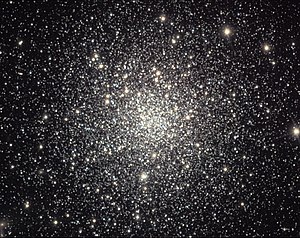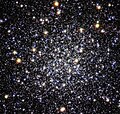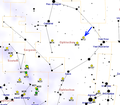M12 (球状星团)
M12或Messier 12,也称为NGC 6218,是在星座蛇夫座的一个球状星团。它是由法国天文学家夏尔·梅西耶于1764年5月30日发现的,他将其描述为“没有恒星的星云”[8]。在黑暗的条件下,用双筒望远镜可以看到这个微弱地星团。解析恒星成员需要一架孔径为8英寸(20厘米)或更大的望远镜[9]。使用10英寸(25 cm)望远镜,颗粒核的直径为3′(弧分),周围环绕着10′的恒星晕[8]。
| M12(Messier 12) | |
|---|---|
 蛇夫座的球状星团M12 | |
| 观测数据(J2000 历元) | |
| 分类 | IX[1] |
| 星座 | 蛇夫座 |
| 赤经 | 16h 47m 14.18s[2] |
| 赤纬 | –01° 56′ 54.7″[2] |
| 距离 | 16.44 ± 0.16 kly(5.04 ± 0.05 kpc)[3] |
| 视星等 (V) | 6.7[4] |
| 视直径(V) | 16.0′ |
| 物理性质 | |
| Mass | 8.7×104[5] M☉ |
| 半径 | 37.2 ly[NB 1] |
| 金属量 | –1.14[6] dex |
| 估计年龄 | 13.8 ± 1.1 Gyr[3] |
| 其它名称 | NGC 6218[7] |
M12大致位于星团M10的西北方3°[9],在恒星列肆二(蛇夫座λ)°东南偏东,相距5.6°。它也位于6等星列肆增四(蛇夫座12)的附近[10]。星团距离地球16,400光年(5,000秒差距)[3],空间的直径约为75光年。M12最亮的恒星视星等为12等。M10和M12彼此间的距离只有几千光年,星团互看对方的是星等大约都是4.5等[10],在夏普力-索耶集中度分类法的评级为IX[1],是一个松散的球状星团,因而曾经被认为是一个紧密集中的疏散星团。在这个星团中已经记录了13颗变星。M12正以16公里/秒的速度向我们逼近[11]。

2006年发表的一项研究得出结论,该星团的低质量恒星数量异常少。作者推测,它们是通过穿过银河系相对富含物质的平面而被从星团中剥离出去的[12]。
相关条目 编辑
注解 编辑
- ^ 线半径 = 距离 × sin(角直径/ 2 ) = 37.2 光年
参考资料 编辑
- ^ 1.0 1.1 Shapley, Harlow; Sawyer, Helen B., A Classification of Globular Clusters, Harvard College Observatory Bulletin, August 1927, 849 (849): 11–14, Bibcode:1927BHarO.849...11S.
- ^ 2.0 2.1 Goldsbury, Ryan; et al, The ACS Survey of Galactic Globular Clusters. X. New Determinations of Centers for 65 Clusters, The Astronomical Journal, December 2010, 140 (6): 1830–1837, Bibcode:2010AJ....140.1830G, S2CID 119183070, arXiv:1008.2755 , doi:10.1088/0004-6256/140/6/1830.
- ^ 3.0 3.1 3.2 Gontcharov, George A.; Khovritchev, Maxim Yu; Mosenkov, Aleksandr V.; Il'In, Vladimir B.; Marchuk, Alexander A.; Savchenko, Sergey S.; Smirnov, Anton A.; Usachev, Pavel A.; Poliakov, Denis M. Isochrone fitting of Galactic globular clusters – III. NGC 288, NGC 362, and NGC 6218 (M12). Monthly Notices of the Royal Astronomical Society. 2021, 508 (2): 2688–2705. arXiv:2109.13115 . doi:10.1093/mnras/stab2756.
- ^ M12. SEDS Messier Catalog. [27 April 2022]. (原始内容存档于1 July 2022).
- ^ Marks, Michael; Kroupa, Pavel, Initial conditions for globular clusters and assembly of the old globular cluster population of the Milky Way, Monthly Notices of the Royal Astronomical Society, August 2010, 406 (3): 2000–2012, Bibcode:2010MNRAS.406.2000M, S2CID 118652005, arXiv:1004.2255 , doi:10.1111/j.1365-2966.2010.16813.x. Mass is from MPD on Table 1.
- ^ Forbes, Duncan A.; Bridges, Terry, Accreted versus in situ Milky Way globular clusters, Monthly Notices of the Royal Astronomical Society, May 2010, 404 (3): 1203–1214, Bibcode:2010MNRAS.404.1203F, S2CID 51825384, arXiv:1001.4289 , doi:10.1111/j.1365-2966.2010.16373.x.
- ^ [ M 12] 请检查
|url=值 (帮助). SIMBAD. 斯特拉斯堡天文资料中心. - ^ 8.0 8.1 Thompson, Robert Bruce; Thompson, Barbara Fritchman, Illustrated guide to astronomical wonders, DIY science O'Reilly Series, O'Reilly Media, Inc.: 137, 2007, ISBN 978-0596526856.
- ^ 9.0 9.1 Monks, Neale, Go-To Telescopes Under Suburban Skies, Patrick Moore's Practical Astronomy Series, Springer: 118, 2010, ISBN 978-1441968500.
- ^ 10.0 10.1 O'Meara, Stephen James; Levy, David H., Deep-Sky Companions: The Messier Objects, Cambridge University Press: 68, 1998 [2024-05-28], ISBN 978-0521553322, (原始内容存档于2023-09-02).
- ^ Messier 12: Gumball Globular | Messier Objects. www.messier-objects.com. 11 March 2015 [2015-08-17]. (原始内容存档于2016-03-04).
- ^ How to Steal a Million Stars?, ESO, February 7, 2006, (原始内容存档于February 8, 2007).
外部链接 编辑
维基共享资源中相关的多媒体资源:Messier 12
- Messier 12, SEDS Messier pages (页面存档备份,存于互联网档案馆)
- Messier 12, Galactic Globular Clusters Database page (页面存档备份,存于互联网档案馆)
- 'Stolen' stars article at Universe Today (页面存档备份,存于互联网档案馆)
- Messier 12, Amateur astrophotographer (hgg) with a Celestron 9.25" (页面存档备份,存于互联网档案馆)
- WikiSky上关于M12 (球状星团)的内容:DSS2, SDSS, GALEX, IRAS, 氢α, X射线, 天文照片, 天图, 文章和图片


